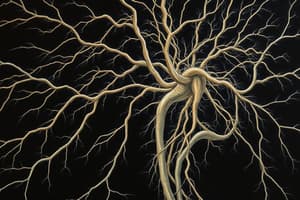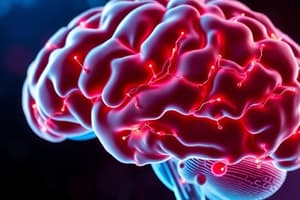Podcast
Questions and Answers
The nervous system consists of the central nervous system (CNS), which includes the brain and ______ cord, and peripheral nerves.
The nervous system consists of the central nervous system (CNS), which includes the brain and ______ cord, and peripheral nerves.
spinal
The nervous system is a key component of ______ in the human body, responsible for automatic control and reaction to the surroundings.
The nervous system is a key component of ______ in the human body, responsible for automatic control and reaction to the surroundings.
homeostasis
Receptors in the skin detect stimuli, sending electrical impulses through sensory neurons to the ______.
Receptors in the skin detect stimuli, sending electrical impulses through sensory neurons to the ______.
CNS
At the end of a sensory neuron, a junction called a synapse releases a chemical that triggers an electrical impulse in a relay neuron in the ______.
At the end of a sensory neuron, a junction called a synapse releases a chemical that triggers an electrical impulse in a relay neuron in the ______.
The electrical impulse in the relay neuron then triggers an impulse in a motor neuron, which sends an electrical signal to an effector (usually a ______) to bring about a response.
The electrical impulse in the relay neuron then triggers an impulse in a motor neuron, which sends an electrical signal to an effector (usually a ______) to bring about a response.
Reflex arcs are a common example of the nervous system's role in enabling humans to react to their surroundings and coordinate ______.
Reflex arcs are a common example of the nervous system's role in enabling humans to react to their surroundings and coordinate ______.
Flashcards are hidden until you start studying
Study Notes
- The nervous system is a key component of homeostasis in the human body, responsible for automatic control and reaction to the surroundings.
- The nervous system consists of the central nervous system (CNS), which includes the brain and spinal cord, and peripheral nerves.
- Receptors in the skin detect stimuli, sending electrical impulses through sensory neurons to the CNS.
- At the end of a sensory neuron, a junction called a synapse releases a chemical that triggers an electrical impulse in a relay neuron in the CNS.
- The electrical impulse in the relay neuron then triggers an impulse in a motor neuron, which sends an electrical signal to an effector (usually a muscle) to bring about a response.
- Reflex arcs are a common example of the nervous system's role in enabling humans to react to their surroundings and coordinate behavior.
- In the case of touching a hot object, the stimulus (heat) is detected by a receptor, triggering an electrical impulse that travels to the CNS and then to a motor neuron, causing a muscle contraction (the response) to pull the hand away from the heat.
- Reflexes are automatic and rapid, bypassing the need for conscious decision-making in the brain.
Studying That Suits You
Use AI to generate personalized quizzes and flashcards to suit your learning preferences.




